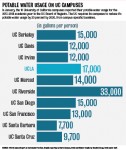UCLA has undertaken several water conservation projects since 2013 because of the California drought and Gov. Jerry Brown’s emergency water restrictions, including replacing the Intramural Field’s grass with artificial turf.
Los Angeles is part of the almost 50 percent of California currently facing exceptional drought, according to the U.S. Drought Monitor. UCLA’s water conservation projects in response to these conditions have saved more than nine million gallons of water in the last year.
Current University of California policy created in January 2014 calls for a 20 percent reduction in water usage from the 2000-2001 academic year baseline by 2020. UCLA has reduced its water consumption by over 10 percent, said Emma Sorrell, sustainability manager for UCLA Housing and Hospitality Services.
However, the school’s usage is still greater than that of most other UC campuses. UCLA consumed 17,000 gallons of water per person in the 2013-2014 academic year, making it the campus that uses the second most amount of water per person after UC Riverside, according to the 2014 UC Annual Report on Sustainable Practices.
UCLA Facilities currently complies with the Los Angeles Department of Water and Power’s watering restrictions, which only allows watering three days a week. The maintenance staff only power-washes sidewalks on an as-needed basis and only waters plants and grass on allowed days.
Sorrell said UCLA Facilities officials have also converted more than half of the spray irrigation systems on the Hill to drip irrigation systems, which water the soil directly around the roots so less water is lost through evaporation.
Chief Sustainability Officer Nurit Katz said water-efficient landscaping projects throughout UCLA have also saved a large amount of water. She added the greatest savings came from replacing the Intramural Field with artificial turf, which is expected to save more than 6.5 million gallons of water each year.
Katz did not have the exact figures of the cost of the installation, but she said the LADWP, which offers rebates to support water conservation projects, funds most of the artificial turf installation and replanting. LADWP offers $3 per square foot for commercial areas, which would equate to more than a million dollars in rebates for replacing the Intramural Field.
The rest of the funding for turf installation and replanting comes from different UCLA departments, depending on which is most affiliated with the project. For example, UCLA Recreation funded the remaining majority of the Intramural Field renovations.
Katz said the sustainability department is currently working with the university to find grant funds and systemwide funding to support drought-related projects.
She added UCLA officials approved the construction of a water filtration system at the cogeneration power plant at the intersection of Westwood Plaza and Charles E. Young Drive.
The plant currently accounts for over 20 percent of campus water usage. There is no definite cost for the installation because the sustainability department is currently evaluating bids, Katz said. She said she expects the filtration system to be installed before the end of this year.
Sorrell said UCLA Facilities workers also replaced 5,100 toilets, shower heads and faucets in residential buildings with high-efficiency models and converted more than 200 urinals on campus to low flow urinals that use two cups of water per flush, rather than one to three gallons. The project is estimated to save over 29 million gallons of water per year and $47,000 in On Campus Housing utility costs.
Conservation campaigns on the Hill encourage students to take five-minute showers and combine laundry loads. UCLA Housing and Hospitality officials also post informational stickers on restroom mirrors and educate staff on water-saving strategies, Sorrell said.
“Education plays a vital role in encouraging students to modify behavior and use water more efficiently,” Sorrell said.
Chrissy Keenan, a third-year human biology and society student and director of 7,000 in Solidarity, said she is using less water by turning off the faucet when she brushes her teeth and drinking from reusable water bottles.
“Many people make the excuse that an individual person saving water won’t make a difference, but I don’t buy into that,” she said. “It’s important for everyone to join the conservation effort.”
The Westwood Village community has joined UCLA in water conservation efforts by using less water for cleaning public areas and installing water-efficient landscaping.
Andrew Thomas, executive director of the Westwood Village Improvement Association, also known as the BID, said Westwood Village maintenance teams are only using 15 to 20 percent of the water they used before the drought. The BID, which takes care of public spaces that are not owned by particular businesses, funded a project to replace the asphalt around trees with more absorbent decomposed granite to save water.
Some Westwood Village restaurants are limiting the amount of water they offer to customers and use to clean dishes.
Nick Jacobs, owner of The Glendon Bar and Kitchen, said the restaurant started to outsource some of its water usage a couple months ago by selling about 30 percent more bottled water than before.
Raymond Mendoza, manager at Novel Cafe said since the drought, the dishwasher machines use recycled water and the kitchen staff scrubs the dishes without running the tap.

Destroy the environment even more by putting plastic all over it. Artificial turf is not the answer.